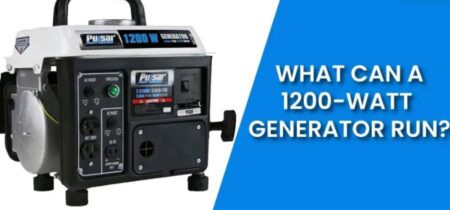
In times of electrical outages, generators are essential devices that convert mechanical energy into electrical energy to provide power to household appliances and devices. They serve as a lifeline to keep your most important appliances such as refrigerators, air conditioning, and even medical equipment running. While transfer switches are the recommended approach to connect a generator to a home’s electrical system, they can be financially demanding and complicated to install.
If you know how to connect a generator to a house without transfer switch, it could be a cost-effective power solution to a home during an outage or external unforeseen calamities. In this article, I will provide a comprehensive guide to connecting a generator to a house without a transfer switch, accompanied by safety tips that are crucial to note.
What is a Transfer Switch?
A transfer switch is an integral electrical component that enables the secure and efficient transfer of power from a primary power source to a backup power source during a power disruption or outage. It’s a critical element of standby generator systems and is used in different settings like residential, commercial, and industrial applications.
The transfer switch operates automatically by disconnecting the electrical load from the primary power source once it detects a power supply interruption. Eventually, the switch connects the load to the backup power source- typically a generator or battery backup system. This effortless transfer occurs without any interruption to the power supply ensuring that electrical equipment and systems continue to function smoothly and securely.
Why Connect a Generator with a Transfer Switch?
Although transfer switches are generally recommended for connecting generators to a home’s electrical system, certain circumstances may come off as unnecessary. For example, if you own a small portable generator, it may not possess the capacity to power the entire home’s electrical system. In such cases, it’s better to power only the essential appliances and devices which are directly connected to the generator.
Moreover, a homeowner who doesn’t have the financial resources to install a transfer switch may opt to connect the generator directly to the home’s electrical system as a more cost-effective alternative. Nevertheless, it’s crucial to recognise the potential risks associated with connecting a generator without a transfer switch. Connecting a generator without a transfer switch can cause electricity to flow back into the grid, posing a risk of electrocution to utility workers or those in contact with downed power lines.
Therefore, you should take necessary precautions like the proper grounding of the generator, disconnecting the home from the grid before connecting the generator, and adhering to safety guidelines to reduce the risk of accidents.
Equipment and Materials Needed to Set up the Generator
Before setting up a generator to power your home without a transfer switch, it’s important to have the necessary equipment and materials.
- Portable Generator: This will be the alternative power source.
- Heavy-Duty Extension Cords: These cords will be used to connect the generator to the appliances or devices that need power.
- Generator Interlock Kit or Manual Transfer Switch: While not essential, installing a generator interlock kit or manual transfer switch can help prevent back-feeding into the grid.
- Voltmeter: This tool will be used to ensure the voltage output of the generator is correct.
- Grounding Rod: This will ensure that the generator is grounded properly and reduces the risk of electrocution.
Safety Precautions when Setting up a Generator
It’s essential to prioritize safety when setting up a generator. Some necessary precautions include:
- Always ensure that the generator is placed outside in a well-ventilated area to avoid the buildup of harmful fumes.
- Turn off all appliances and devices before connecting the generator to avoid damage or injury.
- Ensure that the generator is not overloaded and can handle the wattage requirements of the devices and appliances you wish to power.
- Use heavy-duty extension cords that are rated for outdoor use and capable of handling the wattage requirements of the devices and appliances.
- Wear safety gear, such as gloves and protective eyewear, when handling electrical equipment to prevent injury.
- Do not touch the generator or electrical equipment with wet hands or while standing in water.
- Use a ground fault circuit interrupter (GFCI) to prevent electrocution.
- Keep the generator away from flammable materials such as fuel, oil, or dry vegetation.
- Regularly inspect and maintain your generator to ensure it’s in good working condition.
By taking these precautions and using the necessary equipment and materials, you can safely and effectively connect a generator to your house without a transfer switch.
How to Connect a Generator to a House without Transfer Switch?
It’s important to recognize the potential hazards when connecting a generator to a house without a transfer switch. A transfer switch serves as a safety mechanism by isolating the generator from the main power supply and ensuring a secure transfer of power. If a transfer switch is unavailable, precautions must be taken to connect the generator to your home safely.
These precautions include using heavy-duty extension cords, ensuring proper grounding, monitoring the wattage capacity, and wearing safety gear when handling electrical equipment. By following these safety measures, you can safely and effectively connect a generator to your home without a transfer switch.
Step 1: Choose a Suitable Generator
Before connecting a generator to your home, you should select an appropriate generator for your power needs. This involves calculating the total wattage of your home’s electrical system and selecting a generator that can handle that amount. It’s important to consider that certain appliances and devices may have higher starting wattage requirements than their running wattage, which should also be taken into account during the selection process.
Step 2: Select the Right Extension Cord
Once you have the right generator for your home’s power needs, you’ll need to select an extension cord that’s suitable for the job. Look for an extension cord that’s rated for outdoor use, heavy-duty, and capable of handling the wattage output of your generator. You’ll also need to ensure that the cord is long enough to reach your generator to your home’s electrical system.
Step 3: Prepare the Electrical System
Before connecting your generator to your home’s electrical system, it’s important to prepare the system. First, turn off all circuit breakers in your home’s electrical panel. This will prevent the generator from back-feeding into the utility lines and potentially causing damage to the generator or electrical equipment.
Step 4: Connect the Extension Cord
Next, connect the extension cord from the generator to an outdoor electrical outlet. This outlet should be located away from any windows or doors to prevent carbon monoxide from entering the house. You can then connect appliances and electrical devices directly to the generator using additional extension cords.
Step 5: Power Up the Generator
With the generator connected to the electrical system, it’s time to start it up. Follow the manufacturer’s instructions for starting the generator, and allow it to warm up for a few minutes before connecting any appliances or electrical devices. Once the generator is running, you can start connecting devices to the generator using the extension cords.
Step 6: Monitor the System
It’s important to continuously monitor the electrical system while the generator is in use. Check the generator’s oil and fuel levels regularly, and be sure to turn off any appliances or electrical devices before shutting down the generator. It’s also important to never overload the generator by connecting too many devices at once or devices with a high wattage requirement.
A Generator can be Wired into a Home in Several Ways
- Wiring Through a Breaker Box : You can attach the generator to the breaker box by using a wired separate breaker
- Direct wiring to the main electrical panel: While it’s not advised, you can use a sub-panel to connect the generator directly to the main electrical panel.
- Using a transfer switch for wiring: A transfer switch joins the generator to the main electrical panel and cuts off the electricity to the house’s appliances when necessary.
- Relay wiring: A relay can be linked to the main electrical panel and stops the power supply from the appliance to the house when it is required.
- Using a Power Inverter to Connect to the House: A power inverter converts DC power from the generator to AC power for appliances. Set the transfer switch to the generator during a power outage, and to “auto” or “normal” when power returns.
Regardless of the method, it’s important to observe these safety precautions and ensure that the wiring is carried out by a qualified electrician.
How to connect a generator to a house without transfer switch Conclusion
The process of connecting a generator to a house without a transfer switch requires an in-depth understanding of the equipment and safety measures. To begin with, selecting the appropriate generator that aligns with the power requirements of the house is necessary.
Furthermore, the usage of heavy-duty extension cords and proper grounding of the generator is also crucial. Prioritizing safety through the use of protective gear, proper placement of the generator in a well-ventilated area, and other safety measures mentioned should be noted.
One should always avoid operating the generator indoors or near open windows or doors. Following these regulations and guidelines are pivotal to connecting a generator to a house without a transfer switch.
Also Read:








